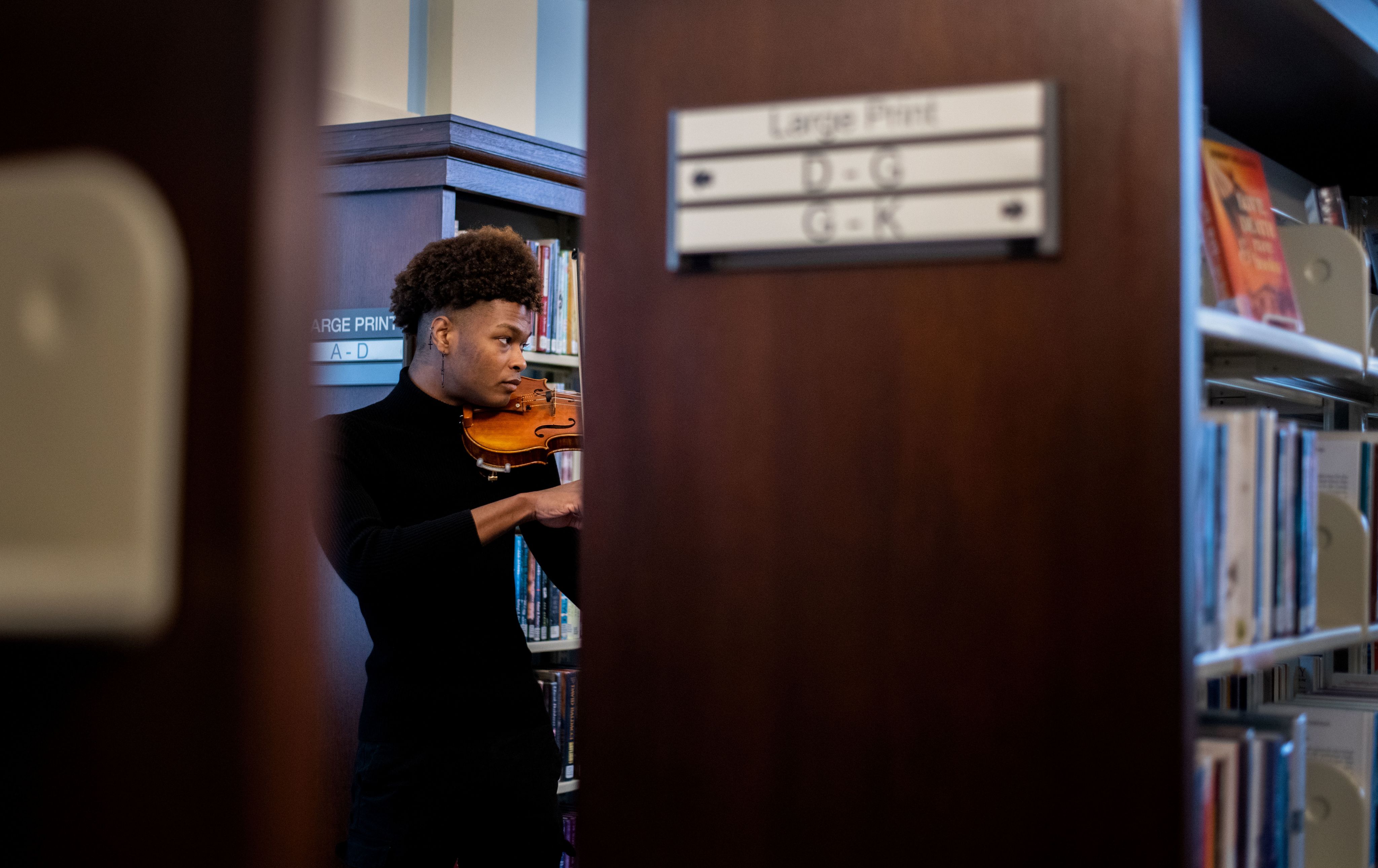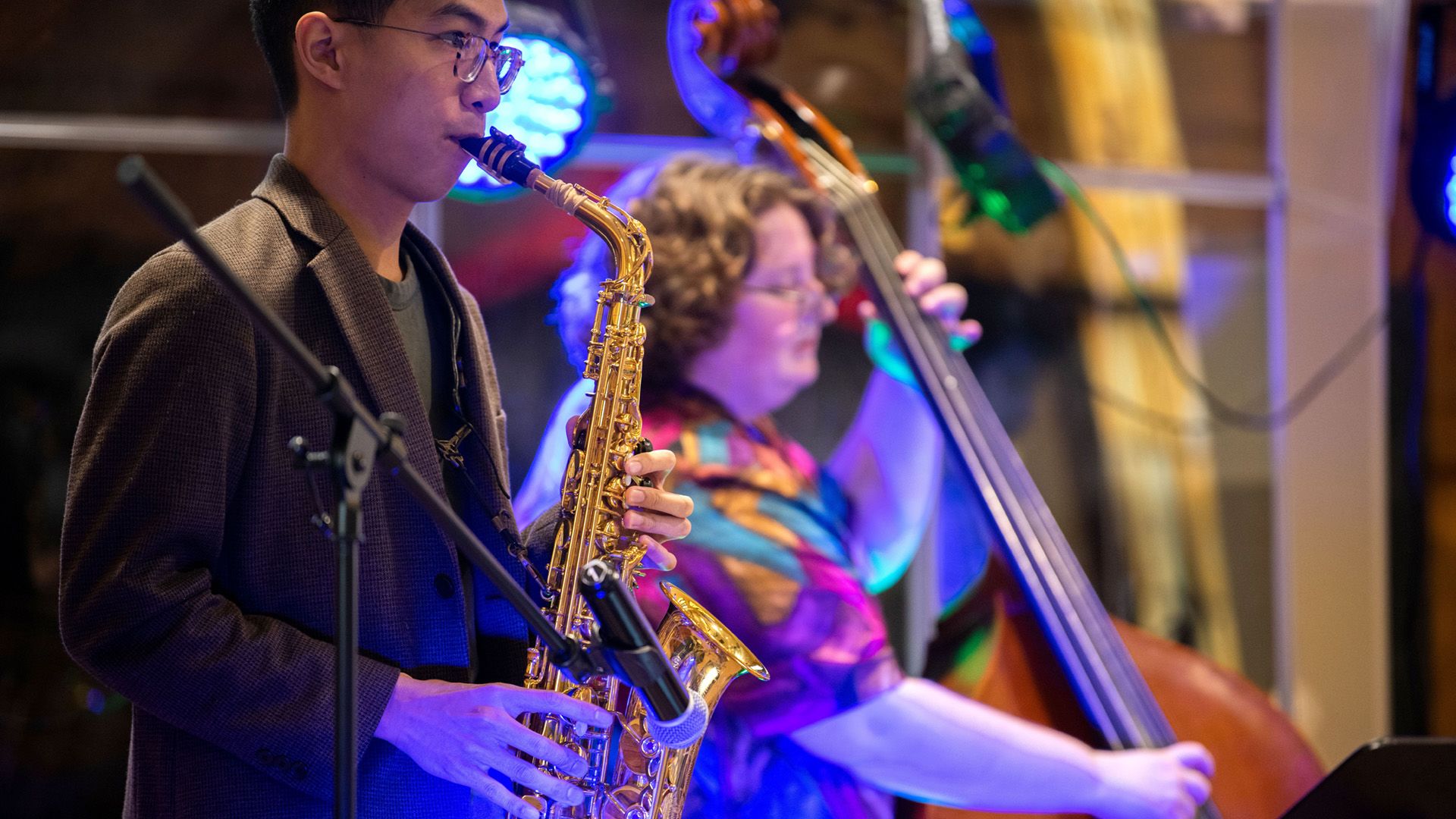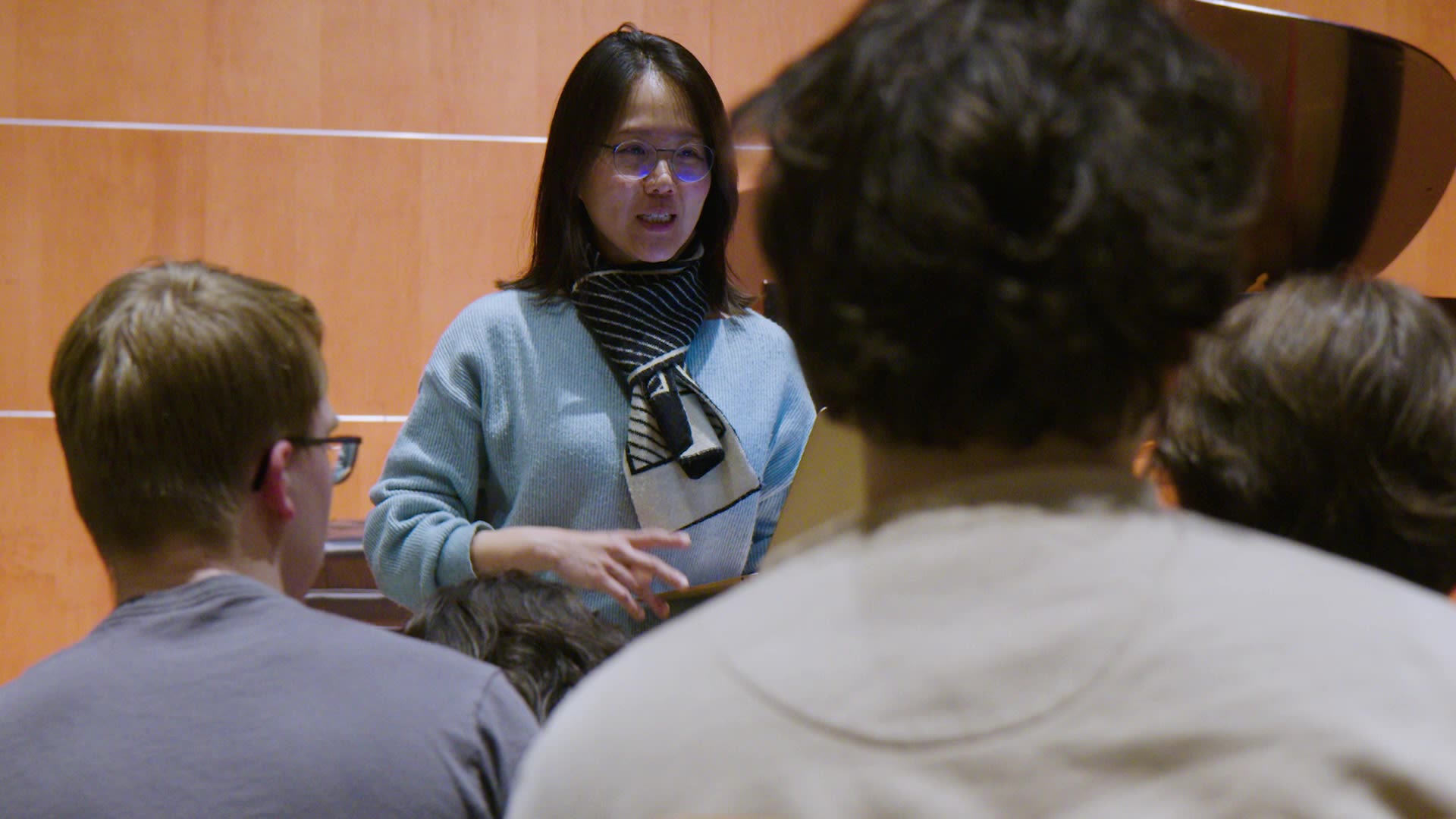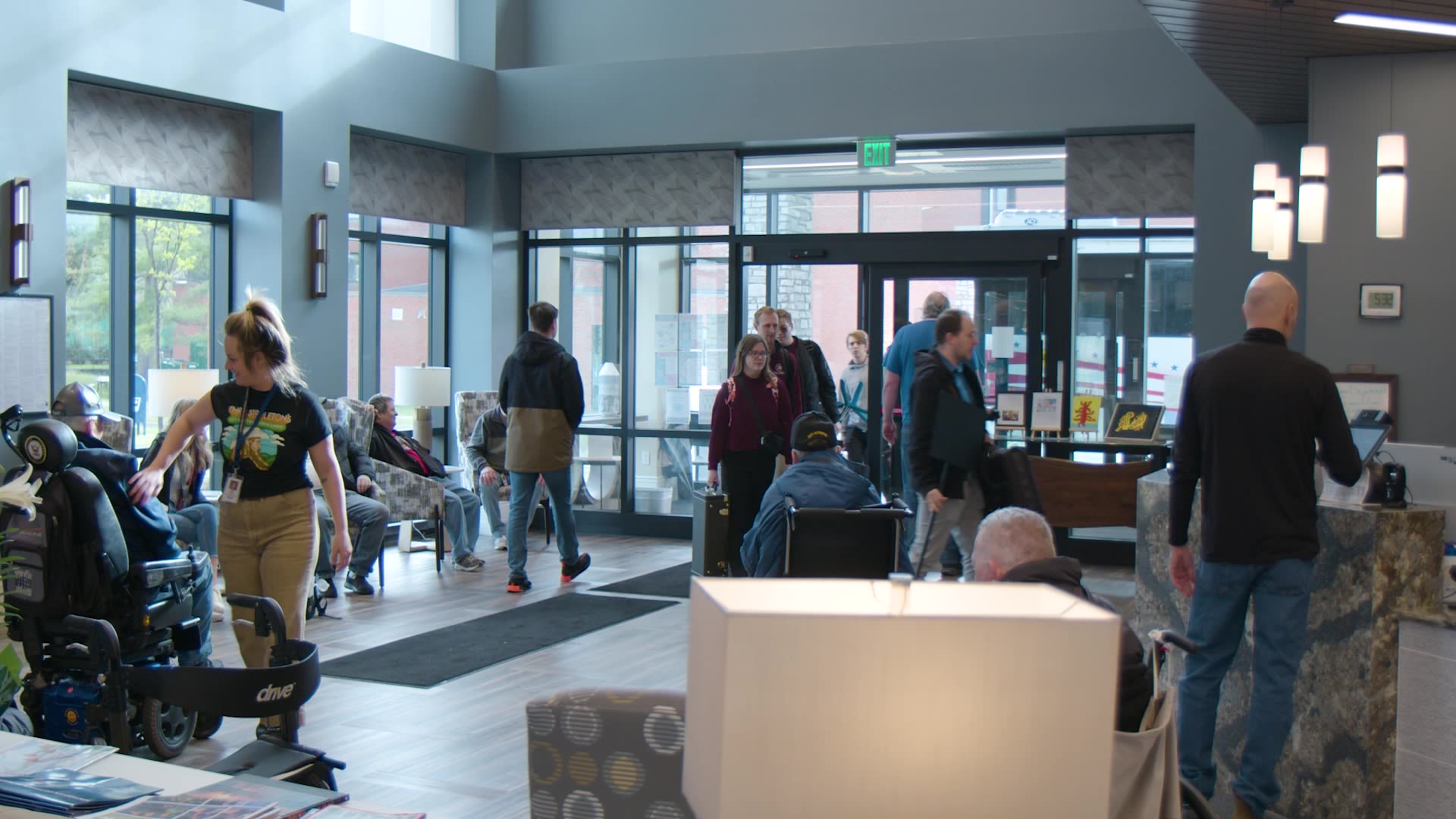Finding Their
‘Why’ as Musicians

Community engagement program stretches student performers, helps them see how their music connects to the world
STORY BY PEG WEST / VIDEO BY TONY PACKER / PHOTOS BY KENDRA STANLEY-MILLS
Grand Valley music students ventured this spring from the familiar environs of the Haas Center for Performing Arts to unfamiliar community spaces in West Michigan to share their craft.
In doing so, they also ventured from the familiar, albeit rigorous, academic setting of practicing and studying with pieces of music — often classical — that are customarily appreciated by expert musicians and known for honing their musicianship. And they ventured from the audiences who typically attend their performances.
They played for people in hospitals and assisted living facilities. Those at a homeless shelter. Members of a veterans home. Library patrons. Staff and students at schools. And those participating in programs through nonprofit organizations.
Students perform a concert at the Grand Rapids Public Library.
Students perform a concert at the Grand Rapids Public Library.
“It's the belief that true musicianship-building doesn't come from simply practicing and studying; it comes from realizing how one relates to the world through one's own craft.”
Sookkyung Cho, associate professor of piano
But these were not concerts simply featuring pieces the musicians wanted to present. These were interactive concerts featuring pieces the musicians tailored to the audiences that day.
Interaction before and during the concerts is at the heart of the Community Engagement Music Project, which launched during the 2023-2024 academic year with the support of a Teaching Innovation Grant through the Pew Faculty Teaching and Learning Center.
These performances went well beyond playing music. Before the musicians rehearsed a single note, a small team of students and sometimes faculty members conducted site visits to learn more about the organizations and understand more deeply the audience members for each concert as well as the setting and musical preferences. That site-visit team then relayed insight about the environments to the musicians as they prepared for performances.
So, the students played Disney tunes, rock, pop, jazz, ragtime, special compositions and, still, some classical. Playing in these settings meant adjusting to the acoustics and, for those performing on a piano, adjusting to the instrument that was in the building.
One of the faculty co-leaders of the project, Sookkyung Cho, described the motivation for the project this way: “It's the belief that true musicianship-building doesn't come from simply practicing and studying; it comes from realizing how one relates to the world through one's own craft.”
New City Kids

Damoni Horton tries out the double bass with the instruction of student performer Julia Droscha, left, at New City Kids after the performance.
Damoni Horton tries out the double bass with the instruction of student performer Julia Droscha, left, at New City Kids after the performance.
From left, Sean MacDonald, Brooklyn Mefford and Khalshawn Jenkins pretend to play imaginary saxophones during a performance by the GVSU Jazz Ensemble.
From left, Sean MacDonald, Brooklyn Mefford and Khalshawn Jenkins pretend to play imaginary saxophones during a performance by the GVSU Jazz Ensemble.
Right from the start, the double bass caught the kids’ eyes.
As the chairs filled with students who are part of New City Kids, an after-school program in Grand Rapids that serves children from first-eighth grades, eyes brightened and they talked excitedly when they saw the upright instrument.
Before long, the children also mimicked playing drums or saxophone as members of the GVSU jazz ensemble invited them to interact as they performed their music but also singularly demonstrated their instruments and explained the different kinds of grooves. They encouraged vocalizations such as “Ommm papaba.”
The expectations for the performance were set up by Evan Lauchie, the music director for New City Kids, where musical development is a key component of the program as teens teach the younger kids how to play instruments.
“We wanted to do a lot of outreach and education with this music event because when children are younger, sometimes they don't have as much exposure to jazz music and it's really a fun, free form, creative, intuitive form of music that anyone can play and sing along to and get the beat going.”
Delaney Novach, jazz ensemble member who performed at New City Kids

“We wanted to do a lot of outreach and education with this music event because when children are younger, sometimes they don't have as much exposure to jazz music and it's really a fun, free form, creative, intuitive form of music that anyone can play and sing along to and get the beat going.”
Delaney Novach, jazz ensemble member who performed at New City Kids

He playfully instructed the kids on proper jazz etiquette while listening: “Jazz is really cool … Let me see your cool face.”
Lauchie considers music the ultimate unifier, “the most powerful tool on the planet.” And he was excited about how the GVSU performers could help the children in his program see possibilities.
“I hope that walking away from this, our kids are inspired to want to pursue music more and hopefully they can see themselves in some of the young adults performing and say, ‘Hey, maybe one day I can go to Grand Valley and I can do music,” he said.
After the performances, which included a Sergei Rachmaninoff piano selection from student Sam Bergman, the GVSU students left the stage to interact with the New City Kids audience.
The kids checked out the instruments, and the double bass continued to fascinate. GVSU student performer Julia Droscha explained the instrument to each child while some of them plucked at a string to their delight.
Unifying, indeed.
Landyn Robinson, right, laughs as he gives a double bass a try while Declan Marshall, left, laughs at the sound.
Landyn Robinson, right, laughs as he gives a double bass a try while Declan Marshall, left, laughs at the sound.
John Dannug, left, plays the saxophone during the concert at New City Kids, while Julia Droscha plays the double bass.
John Dannug, left, plays the saxophone during the concert at New City Kids, while Julia Droscha plays the double bass.
Anahi Rodriguez, center, pretends to play an imaginary saxophone during a performance by the GVSU Jazz Ensemble.
Anahi Rodriguez, center, pretends to play an imaginary saxophone during a performance by the GVSU Jazz Ensemble.
Andrew Kales talks about drums and percussion instruments.
Andrew Kales talks about drums and percussion instruments.
Sookkyung Cho

At her studio in the Haas Center for Performing Arts, Sookkyung Cho picked up a container and off-handedly remarked that she needed to “water the piano.”
When others in the room reacted quizzically, Cho explained that the grand piano contains a humidification system to keep it supple. This is essential for the Juilliard-trained pianist, who has performed in top musical venues around the world, to optimize her playing as a professional musician and associate professor of piano.
To be sure, Cho’s professional training is immense, her repertoire elite. But she started to fully understand the meaning of her craft early in her training by playing at community settings such as nursing homes on the instruments, like an upright piano, at the facility.
Sookkyung Cho, associate professor of piano, talks with students during a piano rehearsal for the Community Engagement Music Project.
Sookkyung Cho, associate professor of piano, talks with students during a piano rehearsal for the Community Engagement Music Project.
Performing outside the more controlled elements of a concert venue or music studio, Cho began deeply understanding her “why” as a musician and as an artist citizen in this society. And that is what she hopes her students will experience through this program.
Exiting, however briefly, from the relentless pursuit of musical perfection to play for new audiences who may hold a different appreciation of music helps artists understand the impact of playing not for themselves, but to be part of a community, Cho said.
“To me, the hardest thing to teach as a teacher is to inspire them,“ Cho said. “I can explain how, but if the ‘what’ does not exist and the ‘why’ does not exist, the 'how' won't make sense.“
Some of this experience has a practical side, Cho said. For the students to support themselves as musicians, they need to learn how to play in different settings and how to “lead the world with their music, with their playing or with their teaching.“
And while the unfamiliar settings can present technique challenges, Cho wants the students to draw a deeper lesson than trying to play a perfect note in that moment.
“Sometimes you lose sight of why you want to be better,“ Cho said. “And I think this brings in the perspective of why you want to be better. In the end, if you're a true artist, you’re going to treat every single opportunity equally.“
“To me, the hardest
thing to teach as
a teacher is to
inspire them”
Sookkyung Cho, associate professor of piano

Michigan Veteran Homes at Grand Rapids

As Gretchen Muir, who works as volunteer coordinator and also oversees donations for Michigan Veteran Homes at Grand Rapids, worked with the GVSU performers on musical selections, she thought it might be nice for the members to hear songs that weren't patriotic, for a change of pace.
The GVSU trumpet studio obliged, starting their performance with “25 or 6 to 4“ by the rock band Chicago and continuing with a wide selection of genres as their trumpets filled the air in a space that Alex Wilson, assistant professor of trumpet, praised for its acoustics. One of the final selections was “The Barber of Seville: Overture,“ which was popularized in Bugs Bunny cartoons.
Muir said she was grateful for the intentionality the GVSU team showed in creating the performance, saying music is comforting for members.
“I think anytime you have any type of intergenerational programming, it benefits the members who are different ages,“ said Muir, adding, “A lot of our members connect with music, especially our members who are in the memory care units.“
Alec Bossa performs for members of the Michigan Veteran Homes as part of the Community Engagement Music Program.
Alec Bossa performs for members of the Michigan Veteran Homes as part of the Community Engagement Music Program.
“If you're not performing for people, you're not getting that audience feedback and that interaction. It kind of lights a fire in you as a musician; you just want to keep going and you just want to do more.”
Max Gradisher, trumpet performance major

“If you're not performing for people, you're not getting that audience feedback and that interaction. It kind of lights a fire in you as a musician; you just want to keep going and you just want to do more.”
Max Gradisher, trumpet performance major

Audience members thanked the GVSU performers at the end. One of the audience members sported a GVSU sweatshirt, as two of her daughters attended Grand Valley. Gloria Bixler, who lives at the home with her husband, DeVere, who was in the U.S. Navy, said she enjoyed the concert.
Bixler said the time the students spent there was also beneficial to them.
“I think they need to be with the older generation and see how they're living, and how we live and enjoy life; something like this is wonderful,“ Bixler said.
Max Gradisher, a trumpet performance major, said it was rewarding to see members of the audience smiling and intently listening to the music. He said while performing is important for him given his major, all musicians need to do it.
“If you're not performing for people, you're not getting that audience feedback and that interaction,“ Gradisher said. “It kind of lights a fire in you as a musician; you just want to keep going and you just want to do more.“
From left, students Jack DeHaan, Taylor Seelye and Alex Wilson, assistant professor of trumpet, perform at the Michigan Veteran Homes.
From left, students Jack DeHaan, Taylor Seelye and Alex Wilson, assistant professor of trumpet, perform at the Michigan Veteran Homes.
Gretchen Muir, volunteer coordinator at Michigan Veteran Homes, left, hands out a program prior to the start of the concert.
Gretchen Muir, volunteer coordinator at Michigan Veteran Homes, left, hands out a program prior to the start of the concert.
“I want them to understand that it is their duty as a musician to play for as many people as they can and to play as well as they can, the best that they can.”
Sookkyung Cho, associate professor of piano




















